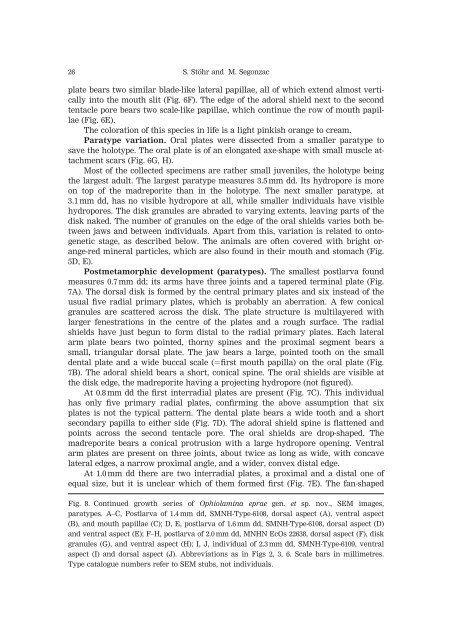from Hydrothermal Vents in the East Pacific - Station Biologique de ...
from Hydrothermal Vents in the East Pacific - Station Biologique de ...
from Hydrothermal Vents in the East Pacific - Station Biologique de ...
Create successful ePaper yourself
Turn your PDF publications into a flip-book with our unique Google optimized e-Paper software.
26 S. Stöhr and M. Segonzac<br />
plate bears two similar bla<strong>de</strong>-like lateral papillae, all of which extend almost vertically<br />
<strong>in</strong>to <strong>the</strong> mouth slit (Fig. 6F). The edge of <strong>the</strong> adoral shield next to <strong>the</strong> second<br />
tentacle pore bears two scale-like papillae, which cont<strong>in</strong>ue <strong>the</strong> row of mouth papillae<br />
(Fig. 6E).<br />
The coloration of this species <strong>in</strong> life is a light p<strong>in</strong>kish orange to cream.<br />
Paratype variation. Oral plates were dissected <strong>from</strong> a smaller paratype to<br />
save <strong>the</strong> holotype. The oral plate is of an elongated axe-shape with small muscle attachment<br />
scars (Fig. 6G, H).<br />
Most of <strong>the</strong> collected specimens are ra<strong>the</strong>r small juveniles, <strong>the</strong> holotype be<strong>in</strong>g<br />
<strong>the</strong> largest adult. The largest paratype measures 3.5 mm dd. Its hydropore is more<br />
on top of <strong>the</strong> madreporite than <strong>in</strong> <strong>the</strong> holotype. The next smaller paratype, at<br />
3.1 mm dd, has no visible hydropore at all, while smaller <strong>in</strong>dividuals have visible<br />
hydropores. The disk granules are abra<strong>de</strong>d to vary<strong>in</strong>g extents, leav<strong>in</strong>g parts of <strong>the</strong><br />
disk naked. The number of granules on <strong>the</strong> edge of <strong>the</strong> oral shields varies both between<br />
jaws and between <strong>in</strong>dividuals. Apart <strong>from</strong> this, variation is related to ontogenetic<br />
stage, as <strong>de</strong>scribed below. The animals are often covered with bright orange-red<br />
m<strong>in</strong>eral particles, which are also found <strong>in</strong> <strong>the</strong>ir mouth and stomach (Fig.<br />
5D, E).<br />
Postmetamorphic <strong>de</strong>velopment (paratypes). The smallest postlarva found<br />
measures 0.7 mm dd; its arms have three jo<strong>in</strong>ts and a tapered term<strong>in</strong>al plate (Fig.<br />
7A). The dorsal disk is formed by <strong>the</strong> central primary plates and six <strong>in</strong>stead of <strong>the</strong><br />
usual five radial primary plates, which is probably an aberration. A few conical<br />
granules are scattered across <strong>the</strong> disk. The plate structure is multilayered with<br />
larger fenestrations <strong>in</strong> <strong>the</strong> centre of <strong>the</strong> plates and a rough surface. The radial<br />
shields have just begun to form distal to <strong>the</strong> radial primary plates. Each lateral<br />
arm plate bears two po<strong>in</strong>ted, thorny sp<strong>in</strong>es and <strong>the</strong> proximal segment bears a<br />
small, triangular dorsal plate. The jaw bears a large, po<strong>in</strong>ted tooth on <strong>the</strong> small<br />
<strong>de</strong>ntal plate and a wi<strong>de</strong> buccal scale (first mouth papilla) on <strong>the</strong> oral plate (Fig.<br />
7B). The adoral shield bears a short, conical sp<strong>in</strong>e. The oral shields are visible at<br />
<strong>the</strong> disk edge, <strong>the</strong> madreporite hav<strong>in</strong>g a project<strong>in</strong>g hydropore (not figured).<br />
At 0.8 mm dd <strong>the</strong> first <strong>in</strong>terradial plates are present (Fig. 7C). This <strong>in</strong>dividual<br />
has only five primary radial plates, confirm<strong>in</strong>g <strong>the</strong> above assumption that six<br />
plates is not <strong>the</strong> typical pattern. The <strong>de</strong>ntal plate bears a wi<strong>de</strong> tooth and a short<br />
secondary papilla to ei<strong>the</strong>r si<strong>de</strong> (Fig. 7D). The adoral shield sp<strong>in</strong>e is flattened and<br />
po<strong>in</strong>ts across <strong>the</strong> second tentacle pore. The oral shields are drop-shaped. The<br />
madreporite bears a conical protrusion with a large hydropore open<strong>in</strong>g. Ventral<br />
arm plates are present on three jo<strong>in</strong>ts, about twice as long as wi<strong>de</strong>, with concave<br />
lateral edges, a narrow proximal angle, and a wi<strong>de</strong>r, convex distal edge.<br />
At 1.0 mm dd <strong>the</strong>re are two <strong>in</strong>terradial plates, a proximal and a distal one of<br />
equal size, but it is unclear which of <strong>the</strong>m formed first (Fig. 7E). The fan-shaped<br />
Fig. 8. Cont<strong>in</strong>ued growth series of Ophiolam<strong>in</strong>a eprae gen. et sp. nov., SEM images,<br />
paratypes. A–C, Postlarva of 1.4 mm dd, SMNH-Type-6108, dorsal aspect (A), ventral aspect<br />
(B), and mouth papillae (C); D, E, postlarva of 1.6 mm dd, SMNH-Type-6108, dorsal aspect (D)<br />
and ventral aspect (E); F–H, postlarva of 2.0 mm dd, MNHN EcOs 22638, dorsal aspect (F), disk<br />
granules (G), and ventral aspect (H); I, J, <strong>in</strong>dividual of 2.3 mm dd, SMNH-Type-6109, ventral<br />
aspect (I) and dorsal aspect (J). Abbreviations as <strong>in</strong> Figs 2, 3, 6. Scale bars <strong>in</strong> millimetres.<br />
Type catalogue numbers refer to SEM stubs, not <strong>in</strong>dividuals.
















